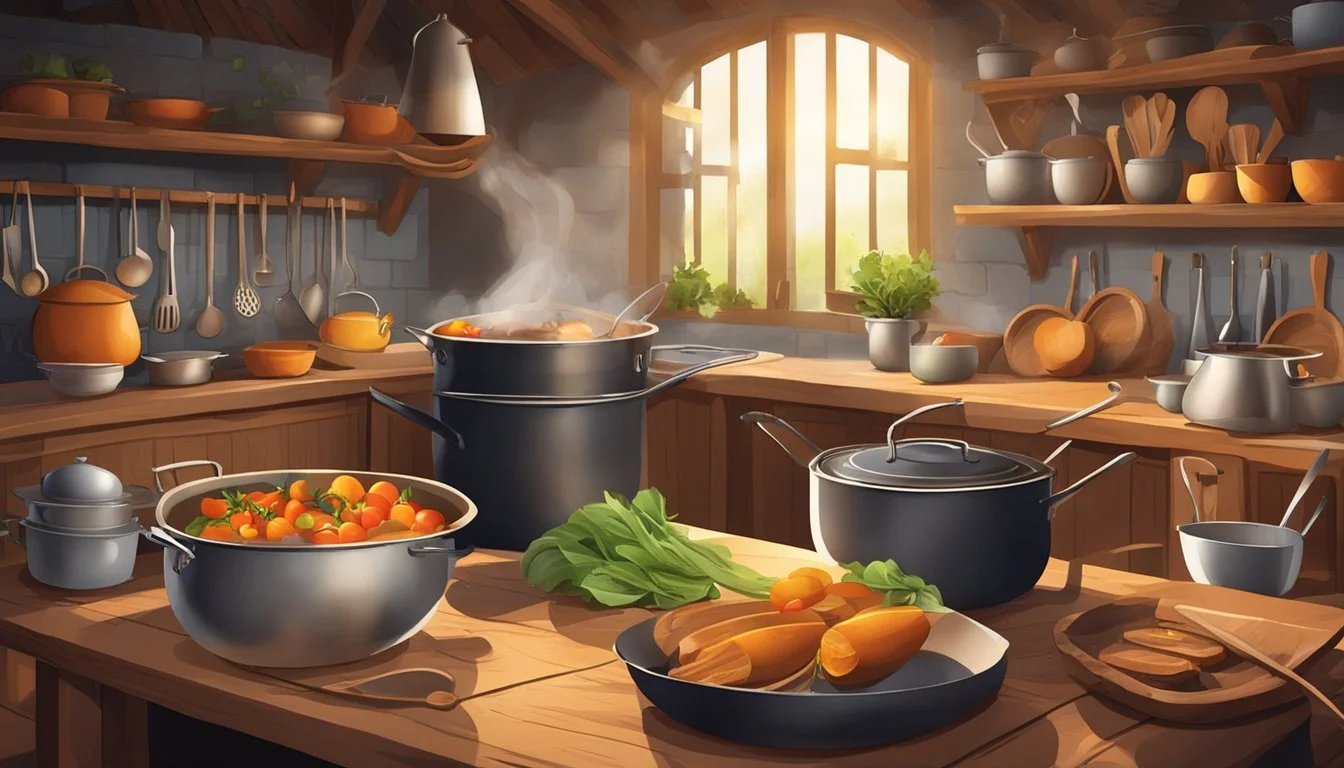The Ultimate Country Easter Feast
Culinary Guide for a Memorable Holiday
With Easter rapidly approaching, the anticipation of a festive dinner (What wine goes well with dinner?) gathers momentum. A quintessential Easter feast is much more than a mere gathering; it is a celebration that combines timeless tradition with the joy of springtime flavors. The process of planning and preparing an Easter dinner can be as rewarding as the meal itself, offering an opportunity to showcase both seasonal ingredients and culinary prowess.
Country-inspired Easter menus typically highlight the freshness of spring with a variety of dishes that please the palate and honor tradition. This might include a succulent, glazed ham as the centerpiece, surrounded by an array of hearty sides like scalloped potatoes, vibrant spring vegetables, and classic deviled eggs. A true country Easter feast is imbued with a sense of home, featuring recipes that are both comforting and festive.
Creating the ultimate Easter menu necessitates a blend of creativity and attention to detail. One might consider incorporating tender pork chops (What wine goes well with pork chops?) or a creamy pasta dish enriched with spring vegetables like snap peas for those seeking a contemporary twist on the classic fare. Each recipe chosen for the Easter dinner should not only reflect the seasonal bounty but also resonate with the warm, inviting spirit of the holiday.
Planning Your Easter Feast
When planning an Easter feast, selecting the right main course is crucial, but it's the variety of side dishes, appetizers (What wine goes well with appetizers?), and desserts that complete this special meal. Each choice should complement the others, creating a harmonious blend of flavors that celebrate the season.
Choosing the Perfect Main Course
The centerpiece of any Easter feast is the main course. One can opt for a traditional glazed ham, succulent and sweet, often paired with a brown sugar or honey glaze. Another favorite is lamb, signifying the essence of spring. For a less traditional route, roast turkey (What wine goes well with turkey?) or salmon (What wine goes well with salmon?) can serve as a flavorful alternative. Regardless of the choice, ensure it is cooked to perfection to impress your guests.
Scrumptious Side Dishes
Easter side dishes offer a chance to showcase fresh spring vegetables:
Asparagus: (What wine goes well with asparagus?) grilled or roasted with a touch of olive oil.
Mashed Potatoes: creamy and buttery, possibly with garlic or cheese.
Scalloped Potatoes: thinly sliced and layered with a rich, creamy sauce.
Potatoes au Gratin: a cheesy variant of scalloped potatoes with a crispy top.
Spring Vegetables: carrots (how long do carrots last?), peas, and green beans lightly sautéed.
The key is to aim for a mix that balances the meal's flavors and textures.
Appetizing Starters
The appetizer course sets the tone:
Deviled Eggs: a classic, often garnished with paprika or herbs.
Pasta Salad: a light option that can be made ahead of time.
Dinner Rolls or Crescent Rolls: to accompany the appetizers.
Upside-Down Radish Tarts: for a unique and visually appealing option.
These appetizers provide a welcoming start without overwhelming the palate before the main course.
Delicious Desserts
Completion of the country Easter feast calls for a memorable sweet note:
Carrot Cake: rich and moist, draped with cream cheese frosting.
Hot Cross Buns: spiced sweet buns with a symbolic cross on top.
Angel Food Cake: light, fluffy, and pairs well with fresh fruit.
Bunny Cake: for those who enjoy thematic treats that charm as much as they taste.
These dessert selections cater to a range of tastes, guaranteeing that every guest finds a favorite to savor.
Cooking Techniques and Tips
To host the ultimate country Easter feast, mastering various cooking techniques is essential. From perfectly roasting meats to crafting mouth-watering desserts, these tips will ensure a memorable meal.
Mastering the Art of Roasting
Roasting is a quintessential method for preparing your Easter centerpiece. Whether it's a glazed ham, roast beef, or turkey, the key is even cooking. Preheat the oven and use a meat thermometer to ensure the correct internal temperature is reached—145°F for ham, 160°F for beef, and 165°F for turkey. For succulent lamb chops (What wine goes well with lamb chops?), marinate with garlic and rosemary before roasting to impart robust flavors.
Slow-Cooked Delights
The slow cooker is an invaluable asset for tender, fall-off-the-bone meats. Crock pot pork roast and slow cooker pork chops become effortless main dishes that free up oven space. Cook on low for several hours until the pork reaches an internal temperature of 145°F. For an Easter twist, try preparing shepherd's pie in the slow cooker as a hearty side dish, layering lamb, vegetables, and creamy mashed potatoes.
Baking Savory and Sweet Treats
Baked goods, from Easter desserts to savory bread, add comfort to any feast. Golden dinner rolls or buttery crescent rolls are must-have side dishes—bake until they have a light brown crust. For sweets, serve traditional hot cross buns or an adorable bunny cake to delight guests of all ages. Bake desserts until they pass the toothpick test, coming out clean when inserted into the center.
Easter-Themed Decorations and Table Settings
Easter dinner is an occasion that combines delicious food with beautiful decor, especially when it comes to the table setting. Centerpieces are the focal point of any Easter table. They can be as simple as a bouquet of fresh spring flowers from a local grocery store or as elaborate as handcrafted eggshell planters.
Here are some creative ideas to elevate an Easter-themed table setting:
Pastel Palette: Embrace the season's colors with a pastel-colored table runner or napkins, complementing the vibrant hues of Easter.
Natural Elements: Incorporate elements like moss, wood, or fresh greenery to bring a touch of nature to the table. Place a dough bowl filled with moss and intersperse it with speckled eggs and bunny statues for a charming rustic look.
Dye with Naturals: Use natural dyes made from beets or other vegetables to create uniquely colored eggs that can be placed around the centerpiece or within floral arrangements.
Candles and Lighting: Soft, chunky candle holders with taper candles add a warm, inviting atmosphere to the dinner table.
Place Setting Tips:
Napkins: Fold napkins in whimsical Easter bunny shapes for a playful touch.
Coasters: Offer handcrafted coasters to protect the table and add a personalized feel.
Remember, the goal is to create a space that feels both festive and elegant. Keep decorations tasteful and avoid overcrowding the table to ensure guests have ample space to enjoy the meal. With these tips, anyone can set up an enchanting Easter table display that complements the feast.
Recipe Collection
The Recipe Collection is a curated assortment of dishes that are perfect for a traditional country Easter feast. From the centerpiece glazed ham to a variety of side dishes featuring spring vegetables, this selection caters to every palate with a balance of classic tastes and diverse flavors.
Signature Easter Recipes
Glazed Easter Ham: The star of the Easter table is often a glazed ham, glistening and deeply flavored with a mix of brown sugar, mustard, and a hint of clove.
Lamb Chops: Tender lamb chops grilled or roasted, make for a savory alternative main dish.
Refreshing Salads and Sides
Asparagus Pasta Salad: Incorporate the freshness of spring with a light asparagus pasta salad tossed with a lemon vinaigrette.
Spring Vegetable Medley: A combination of steamed or roasted spring vegetables such as carrots, spring onions, and tender greens complements any Easter spread.
Delectable Treats and Confections
Carrot Cake: An Easter feast is incomplete without the classic, moist carrot cake, topped with a rich cream cheese frosting.
Angel Food Cake: Light and airy angel food cake serves as a sweet ending that's not too heavy after a filling meal.
Global Easter Traditions
Pizza Rustica: They can take a culinary journey to Italy with a slice of pizza rustica, a hearty pie filled with a mixture of cheeses and cured meats (What wine goes well with cured meats?).
Smothered Pork Chops: For those with a nod to Southern traditions, smothered pork chops bring a homey, comforting touch to the Easter table.
Each recipe has been thoughtfully chosen to celebrate the flavors of spring and embrace the festive spirit of Easter. Whether one opts for the classic glazed ham or explores global traditions, this collection delivers a spread that is sure to be memorable.
Hosting and Entertainment
When hosting an Easter celebration, it is important to not only serve a delightful dinner featuring ham, turkey, or lamb, but also to engage guests with creative activities and effectively manage leftovers to ensure nothing goes to waste.
Creative Activities for Kids and Adults
To keep both children and adults entertained, Easter egg decorating workshops can be a colorful addition. Providing a variety of tools such as paints, stickers, and markers allows everyone to express their creativity. Additionally, an Easter egg hunt is a classic activity that can be enjoyed by all ages. To increase the enjoyment for adults, consider hiding special eggs with numbers corresponding to door prizes.
For a more relaxed entertainment option, a DIY photo booth with Easter-themed props can offer guests a fun way to capture memories from the event. Include bunny ears, hats, and signs with Easter greetings.
Easter Leftovers
Managing leftovers with care ensures that the abundant treats from the Easter feast do not go to waste. Here are some practical ideas:
Ham: Turn leftover ham into breakfast hash, add it to omelets, or make ham and cheese sandwiches for a quick lunch.
Turkey: Turkey can be repurposed into pot pies, soups, or salads for nourishing meals in the following days.
Lamb: Leftover lamb pairs well in wraps with yogurt sauce or can be used to create a hearty lamb ragu for pasta.
To help guests take part in the leftover bounty, prepare take-home containers. Label them with the contents and date, and stack them in an easily accessible area so guests can grab a container as they leave.
Food Safety and Storage
Easter Feasts often involve a variety of traditional dishes, including chicken and salmon, that require careful handling to ensure they are safe to eat. It is imperative for hosts to follow food safety guidelines to prevent foodborne illnesses.
Storing Raw Ingredients:
Chicken: Should be stored in the refrigerator at 40°F (4°C) or lower, ideally on the bottom shelf to prevent cross-contamination.
Salmon: Must be kept refrigerated at 40°F (4°C) or below, or frozen at 0°F (-18°C) if not using immediately.
Preparation Tips:
Always wash hands before and after handling raw meat and fish.
Use separate cutting boards and utensils for raw and cooked foods.
Marinades for raw chicken or salmon should be discarded after use; never reuse marinades for other food items.
Cooking Temperatures: To ensure safety, foods must reach their proper internal temperatures before consumption:
Chicken: 165°F (74°C)
Salmon: 145°F (63°C)
Cool down leftovers within two hours of cooking.
Store in covered containers and refrigerate at 40°F (4°C) or lower.
Consume refrigerated leftovers within 3-4 days.
Reheating: Reheat leftovers thoroughly to an internal temperature of 165°F (74°C), checking with a food thermometer.
By adhering to these guidelines, individuals can enjoy their Easter feast with confidence in the safety and quality of their food.







